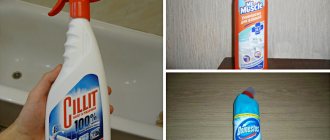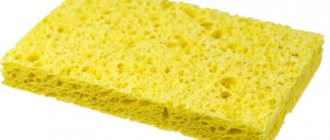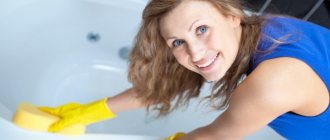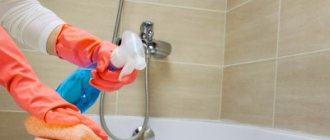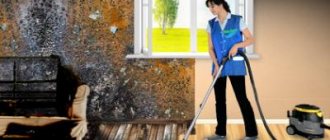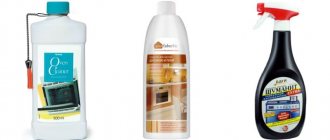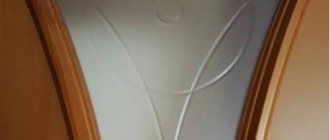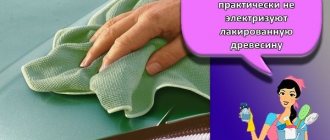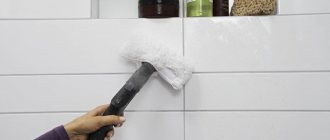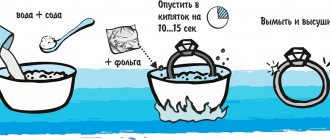Tile in the bathroom is constantly exposed to various types of contamination: soap scum, mold, prints, rust. It is important to keep this room clean, since dirt that mixes with steam can seriously harm your health, and the room itself will look untidy.
Light stains on bathroom tiles can be removed using a shower head and a microfiber cloth Source plitka-ot-zavoda.ru
Causes of plaque formation
The surface of the tiles in the bathroom is constantly exposed to water, soap solutions, and cosmetics. The liquid part evaporates, the drops dry out, leaving stains of salts, lime and other substances dissolved in water on the shiny tile.
It is not difficult to clean the tiles from dirt: water-soluble salts are wiped off with a sponge or rag. But in some cases, stains cannot be removed. The reasons for this may be:
- increased water hardness: after the moisture evaporates, insoluble lime compounds remain, which form white stains on the tiles;
- leaking taps: they stain the wall with rust, and after the drops dry, the yellowness is difficult to wash off;
- mold fungi: colonize tile joints, constantly appearing on the surface in the form of dark spots resembling dirt, and an unpleasant odor appears in the bathroom;
- consequences of the repair: drops of lime, paint, putty or grouting materials are easily washed off until completely set (within 24 hours), and after that they are more difficult to remove.
Washing tiles in the bathroom.
General cleaning recommendations
You need to choose a cleaning agent to remove stains from tiles depending on the type of coating (tile, plastic, terracotta, etc.), as well as taking into account the type of dirt. Fresh stains of any origin can be easily wiped off with a soap and soda solution. Soda, as a soft abrasive, can even cope with rust or lime salts. But old stains will have to be removed with aggressive household chemicals.
Washing tiles with soap and soda solution.
To prevent damage to the wall covering during cleaning, you must follow the following rules for caring for it:
- when using acid-containing chemicals, protect tile joints;
- do not use hard metal sponges and brushes, do not scratch stains with a knife;
- It is better to choose thick gels;
- It will be possible to wash the tiles without streaks only by thoroughly rinsing the surface;
- After treatment, mirror glass tiles must be wiped with window cleaners until they shine.
Caring for an enamel bath
Read also: Latex paint or acrylic: what is the difference and which one is better to choose for different types of work (Photo & Video) + Reviews
Enamel bath
The main rule is that it must be regular and timely. Stains can become deeply embedded in such a surface in just a few days, so it is important to remove them immediately. Choose cosmetics designed to clean enamel.
It is allowed to use powder or paste-like substances. It is advisable to apply them to the walls with generous foam and wait a quarter of an hour. Then rub the enamel well and rinse with water.
Caring for an enamel bath
Carefully read the composition of the drug - there should not be any aggressive acids that can corrode the sensitive coating. Do not use metal brushes or sponges.
Home Remedies
Improvised products are used in emergency situations, when you need to wash away dirt, but it is not possible to buy a suitable product. Limescale removal is carried out using acidic solutions:
Vinegar and lemon juice remove limescale from tiles.
- Vinegar dissolves traces of water droplets and will help remove grout or lime stains. Table varieties should be diluted with water 1:1, and for essence use 1 tsp. for ¾ glass of water. Soak a cloth in the solution and wash the tiles, rinse and wipe.
- Lemon juice or acid solution works in the same way as vinegar. You can use pure lemon juice or an acid solution of 1 tsp. for 1 glass of water.
You can remove cloudy deposits from drops of soapy water on the lining near the sink and bathtub using baking soda: moisten the powder, apply it to a sponge and wipe the wet wall. Rinse off the remaining soda with plenty of water so that there are no streaks from the powder itself.
An old toothbrush is useful for cleaning tile seams, joints in corners and other hard-to-reach places. It is convenient to treat smooth walls with a sponge. For wiping dry, rags made from natural fabrics are suitable.
No. 4. Lemon acid
Modern detergents are, of course, effective, but they also have disadvantages .
- Firstly, household chemicals can cause allergies .
- Secondly, it requires very careful handling, since sometimes the concentrations of aggressive chemicals in them can damage the skin of the hands and even the respiratory tract.
- Thirdly, some products cannot be washed off even with a large amount of water.
Therefore, it is not surprising that today many people abandon store-bought products and switch to using folk remedies.
The most popular and easiest way to clean ceramic tiles from grease , lime deposits and plaque is to use lemon juice . Problem areas should be thoroughly rubbed with lemon and left for a few minutes . Lemon juice can be squeezed out, diluted a little with water and sprayed with a spray bottle . After a few minutes, the juice is washed off with water . The bonus of this method is that the room will be filled with a pleasant and, most importantly, natural aroma.
An alternative is citric acid powder . The bag is dissolved in a glass of warm water and the resulting liquid is used for processing.
Cleaning tiles using traditional methods
If the use of reliable but caustic chemicals is not possible, you can remove dirt and stains on the walls of the bathroom and bring the tiles to a shine using the folk method. You will need:
- 100 ml hot water;
- 100 g of sound soap shavings;
- 2 tbsp. l. hydrogen peroxide;
- 2 tbsp. l. table vinegar (6-9%);
- 75 g baking soda.
Using a special solution prepared at home, you can give the tiles their former shine and shine.
Dissolve the soap in water, adding it in small portions. Add baking soda powder and leave the mixture for 24 hours. Add the remaining ingredients, moisten the tile with water and apply the prepared mixture. Leave for 5-7 minutes, then rub the seams with a brush, rinse the surface of the wall or floor with a sponge. Finally, rinse thoroughly with water and wipe dry.
An ammonia aqueous solution, which is used to wash glass, will also work well with stains on tiles or other glossy tiles (porcelain, mirror, etc.). Ammonia is used after washing the walls in the bathroom to bring the tiles to a shine. Glass cleaners can be used for the same purpose.
No. 10. Chlorine powder (white)
Bleach can cope with the most serious contaminants , it is an effective disinfectant that allows you to simultaneously solve the problem of mold and mildew , so this method is often used in damp rooms. Chlorine powder is diluted in water , the solution is poured into a spray bottle and sprayed onto the contaminated surface for 10-15 minutes , then wipe the tiles with a sponge to remove dirt, and then with a well-dampened rag.
When working with such an aggressive product, you need to wear gloves , or even better, use a mask to protect your respiratory system . It is not recommended to use bleach frequently , otherwise you can not only dissolve plaque, but also damage the surface of the tile and discolor the grout . Some housewives use ready-made liquid such as “Belizny” .
Specialized household chemicals
Many products only remove fresh dirt well. It is difficult to remove old limescale or rust with them.
Silit Bang dissolves fats and breaks down lime deposits.
At home, it is convenient to use strong but not too aggressive drugs:
- "Silit Bang". Breaks down fats, dissolves lime deposits, and can remove yellow rust stains. The composition is non-aggressive towards all materials used for cladding: it can be used to clean acrylic and various types of plastic, porcelain stoneware, tiles with various surfaces, glass.
- "Mister Muscle". Dissolves soap and lime stains, is easily washed off with water and leaves no marks on different types of wall coverings.
- "Comet". The products are available in the form of sprays and gels with cleaning properties. If you need to quickly wipe clean surfaces to maintain shine, use a spray, but it is more convenient to treat difficult stains with gels.
- Kiilto Clean for tiles. The product contains oxalic acid and is harmless to glossy glazed ceramic surfaces, but can damage gypsum grout.
- "Domestos". Thick gels and sprays have a bactericidal effect. The bathroom will not only be clean, but also safe for health. When mold appears, the tile joints are treated with thick gel.
Domestes rids tiles of mold.
Why do stains appear on the floor?
The main problem with tiled flooring is the appearance of foreign marks after cleaning. This happens for the following reasons:
- fat has not been previously removed from the surface;
- the base was washed with hard water;
- excessive use of detergent;
- the cloth used was poorly wrung out;
- The water was not changed during the cleaning process.
If you take into account the above-described nuances when carrying out the cleaning process, then there will most likely not be any stains left on the surface of the floor base.
Ceramic tile floors should be washed using glass cleaners and ammonia: they remove stains and add shine to the surface Source i.ytimg.com
Features of washing different types of tiles
When trying to wipe dirt off tiles, it is advisable to take into account the nature of the surface. On smooth, glossy walls, plaque forms quickly, but it is easy to visually detect and remove immediately. Other types of ceramic tiles need to be cleaned properly to achieve a satisfactory result.
Glossy
Glossy surfaces are especially difficult to keep clean. But it is also easier to remove stains from them than from other types of tiles. Plaque is removed from the glaze using chemicals that contain ammonia or ethyl alcohol: these are most products for window glass. The preparations are equipped with a spray bottle, are easy to apply, and when wiped dry, the surface becomes shiny.
Window glass cleaners are most often used to clean glossy surfaces in the bathroom.
Matte tile
Ceramic tiles without glaze are covered with stains from soap solutions or water. You can eliminate them:
- acidified water (0.5 cup per 5 liters of water), if they are caused by lime deposits;
- a solution of soda ash (3 tablespoons per 5 liters of water);
- special polish.
Cleaning matte tiles in the bathroom.
Embossed
The textured surface of the tile makes it difficult to remove dirt with a simple rag or sponge: not only plaque or rust remains in the small recesses of the pattern, but also dirty water after washing. If they are not removed immediately, they will create a dark coating. For cleaning, it is better to use special products that are completely washed off. The most convenient way to clean an uneven surface with an ornament or simply a fine texture is with a brush. After washing, it is advisable to wipe the wall or floor with moisture-absorbing material.
It is better to wash embossed tiles with special products.
Floor
For bathroom flooring, tiles with fine relief or without glaze are often used. These types are the safest: they will not allow you to slip on a wet floor. They need to be cleaned taking into account the characteristics of the surface, according to the rules for matte or embossed tiles. For floor tiles, special polishes are used (Emsal, etc.), which do not allow dirt to seep into the micropores of the ceramic.
For flooring, you should choose special polishes.
Hard to reach places
The most difficult to clean are the seams between the elements of the tile masonry. You can return them to their original appearance and color only by using harsh products such as ammonia and ethyl alcohol or special gels.
However, they do not provide a 100% guarantee of the desired result. In particularly severe problem cases, the grout will have to be removed with a chisel or a painting knife*. After that, apply a new one.
*Attention! This operation is not recommended if the ceramic masonry is more than 15 years old.
How to clean the seams between tiles
Cleaning the joints between tiles.
The grout has many pores into which dirty cleaning solution, drops of soapy water and other substances become clogged. Fungus and mold often develop in the pores.
To treat the seams, use a small brush and any cleaning product with bactericidal properties. The composition of a folk or store remedy should not include acid. A soap-soda solution is suitable (for 1 liter of water, 50 g of soap shavings and 2 tablespoons of soda). Add 1 cap of “Whiteness” or 0.5 tsp to it. chloramine.
It is convenient to use a steam generator to clean seams. A jet of hot steam destroys dirt and microorganism spores.
Mold Removal
Mold appears as small black spots in the joints of tiles. The peculiarity of the fungus is its ability to live and grow deeply into the plaster, from where it is completely impossible to remove it without repairs. A steam cleaner will quickly fix the problem. If mold was already in the bathroom before the new tiles were installed, the effect will be temporary.
Chlorine bleach will help fight mold on tiles.
Chlorine bleaches are effective against fungus on surfaces, but cannot completely destroy it. To permanently fix the problem, you need to use a radical method - remove the old putty and fill the joints with new grout. A special tool is used to remove the gypsum mixture, and the remains are removed with a brush.
Anti-mold treatment is as follows:
- Inject a fungicidal antiseptic into the seams, trying to wet the entire space between the seams (use a syringe);
- dry the wall;
- fill the joints with new putty, pushing it into the depth of the seam;
- wipe the surface of the tiles.
After introducing the fungicidal antiseptic and drying the wall, it is necessary to reapply the putty.
Methods for restoring grout
There are several effective ways to update and lighten seams:
Marker for cleaning tile joints.
- Hardware stores sell products for cleaning bathroom tile joints. Markers and pencils allow you to quickly work on a seam by running the end of the lead along it.
- Paint the seams with waterproof paint or varnish and cover with polish.
- Partially renew the grout. This process is often combined with mold removal.
- If the putty has crumbled, it can be renewed by applying a fresh layer of the same composition. Before repairs, treat the joints with a stiff brush to remove the crumbling layer.
Let's start cleaning
First, the bathroom needs to be freed of everything that interferes with cleaning. It is necessary to remove all towels, bathing products: washcloths, gels, shampoos, pumice, etc.
- Remove the curtain and throw the rugs into the wash.
- Then you should identify the most contaminated areas and work on them first.
- Apply the product, rub, leave for 15-20 minutes.
- Afterwards, you can begin global cleaning of the tiles and seams.
- If the grout was originally light, you should try using liquid bleach to bleach it.
It is important to use protective gloves when working with any means, even gentle ones.
Useful tips and prevention
To ensure that the seams are less exposed to moisture or cleaning agents, it is recommended that they be treated with a moisture-proof compound immediately after the repair is completed. The grout will last longer. Polishes are also applied to tiles with a porous surface (unglazed).
The best prevention of stains on tiles is timely cleaning. It is easier to wipe the walls when the stains have not yet had time to dry to the surface. You need to wash the walls in the bathroom once a week, and clean the seams once every 2-3 weeks.
Ventilation or frequent airing of the bathroom helps eliminate excess moisture. Mold will not grow in such conditions. After washing or taking a shower, it is advisable to wipe off drops of water from the tiles: this way there will be less dampness, and you won’t have to scrub off the stains.
